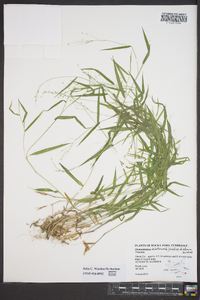Dichanthelium dichotomum subsp. dichotomum
|
|
|
|
Family: Poaceae
Cypress Witch Grass, more...cypress panicgrass
[Dichanthelium dichotomum var. barbulatum (Michx.) Mohlenbr.] |
Culms 20-60 cm, usually slender, erect; nodes usually glabrous, lowermost nodes sometimes sparsely bearded with soft, retrorse hairs; internodes terete, green to purplish, glabrous; fall phase branching freely from the midculm nodes, producing dense clusters of reduced, flat to involute blades and reduced secondary panicles. Cauline sheaths usually glabrous, lowermost sheaths sometimes sparsely pubescent, margins glabrous or short-ciliate; blades usually 3.5-9 cm long, usually 5-7 mm wide (seldom wider), usually spreading, narrowly lanceolate, glabrous on both surfaces, bases constricted. Primary panicles well-exserted; branches few, flexuous, with fewer spikelets than all the other subspecies apart from subsp. lucidum. Spikelets 1.8-2.3 mm, ellipsoid, usually glabrous, rarely purplish at the base; upper florets 1.7-2 mm long, 0.7-1.0 mm wide. 2n = 18. Dichanthelium dichotomum subsp. dichotomum usually grows in dry to mesic woods. Its range extends from southern Ontario to Maine and south through Illinois and Missouri to eastern Texas and to the east coast and central Florida. Perennial herb, tufted 20 cm - 0.6 m tall Inflorescence: a terminal, branched arrangement of spikelets (panicle). Primary panicles atop the culms, 3 - 12 cm long, long-exserted, few-branched. Secondary panicles (when present) atop the branches. Fruit: a caryopsis, indehiscent, enclosed within the persistent lemma and palea. Culm: upright, green to purplish on the internodes, 20 cm - 0.6 m long, slender, round in cross-section, hollow. Lowermost nodes sometimes sparsely bearded with soft hairs pointing down. Fall phase freely branching from mid-culm nodes, producing dense clusters of reduced leaf blades and secondary panicles. Spikelets: about 2 mm long, ellipsoid, prominently veined. Basal leaves: in a rosette. Blades shortly egg-shaped to lance-shaped, distinct from stem blades. Stem leaves: four to seven, alternate, two-ranked. Sheaths usually shorter than internodes, sometimes sparsely hairy on lowermost sheaths, sometimes fringed with short hairs. Ligules about 0.5 mm long, composed of hairs. Blades thin, often spreading, distinctly longer and narrower than basal leaves, 3.5 - 9 cm long, 5 - 7 mm wide, narrowly lance-shaped with a constricted base, parallel-veined. Glumes:: Lower glumes usually less than one-third as long as spikelets, blunt to pointed at the apex. Upper glumes about as long as lower lemmas and upper florets, rounded to pointed at the apex. Lemmas:: Lower lemmas similar to upper glumes. Upper lemmas longitudinally lined, shiny, with rolled-up margins above. Paleas:: Lower paleas shorter than lower lemmas, thin. Upper paleas longitudinally lined. Florets:: Lower florets sterile. Upper florets bisexual, stalkless, about 2 mm long and 1 mm wide, ellipsoid with a blunt to nearly pointed apex, plump. Anthers three. Stigmas red. Similar species: No information at this time. Flowering: May to September Habitat and ecology: Occasional in the eastern sector of the Chicago Region. There it is found in moist sandy woods and low peaty or organic sands. It is also found in sandy savannas. Occurence in the Chicago region: native Etymology: Dichanthelium comes from the Greek words di, meaning twice, and anth, meaning flowering, referring to plants that may have two flowering periods. Dichotomum means "forking in pairs." Author: The Morton Arboretum From Flora of Indiana (1940) by Charles C. Deam Frequent in the northern and southern counties. It is usually found in open places on the crests and slopes of black and white oak woods and less frequently in beech and sugar maple woods. It prefers a poor soil and is sometimes found in the dunes growing in almost pure sand. Some authors separate from this species, under the name of Panicum barbulatum Michx., plants with broad leaves and pubescent nodes. In Indiana the two forms intergrade so that I cannot make a satisfactory division of them. ...... Indiana Coefficient of Conservatism: C = 5 Wetland Indicator Status: FAC |
























































